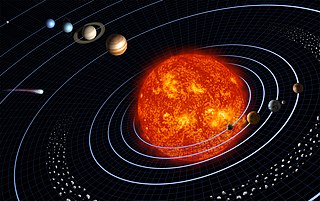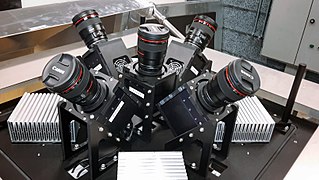
The Very Large Telescope (VLT) is a facility operated by the European Southern Observatory, located on Cerro Paranal in the Atacama Desert of northern Chile. It consists of four individual telescopes, each equipped with a primary mirror that measures 8.2 meters in diameter. These optical telescopes, named Antu, Kueyen, Melipal, and Yepun, are generally used separately but can be combined to achieve a very high angular resolution. The VLT array is also complemented by four movable Auxiliary Telescopes (ATs) with 1.8-meter apertures.

HD 209458 b, which is also nicknamed Osiris after the Egyptian god, is an exoplanet that orbits the solar analog HD 209458 in the constellation Pegasus, some 159 light-years from the Solar System. The radius of the planet's orbit is 0.047 AU, or one-eighth the radius of Mercury's orbit. This small radius results in a year that is 3.5 Earth-days long and an estimated surface temperature of about 1,000 °C. Its mass is 220 times that of Earth and its volume is some 2.5 times greater than that of Jupiter. The high mass and volume of HD 209458 b indicate that it is a gas giant.

Tau Boötis b, or more precisely Tau Boötis Ab, is an extrasolar planet approximately 51 light-years away. The planet and its host star is one of the planetary systems selected by the International Astronomical Union as part of NameExoWorlds, their public process for giving proper names to exoplanets and their host star. The process involved public nomination and voting for the new names, and the IAU planned to announce the new names in mid-December 2015. However, the IAU annulled the vote as the winning name was judged not to conform with the IAU rules for naming exoplanets.

Any planet is an extremely faint light source compared to its parent star. For example, a star like the Sun is about a billion times as bright as the reflected light from any of the planets orbiting it. In addition to the intrinsic difficulty of detecting such a faint light source, the light from the parent star causes a glare that washes it out. For those reasons, very few of the exoplanets reported as of April 2014 have been observed directly, with even fewer being resolved from their host star.

The study of extraterrestrial atmospheres is an active field of research, both as an aspect of astronomy and to gain insight into Earth's atmosphere. In addition to Earth, many of the other astronomical objects in the Solar System have atmospheres. These include all the gas giants, as well as Mars, Venus and Titan. Several moons and other bodies also have atmospheres, as do comets and the Sun. There is evidence that extrasolar planets can have an atmosphere. Comparisons of these atmospheres to one another and to Earth's atmosphere broaden our basic understanding of atmospheric processes such as the greenhouse effect, aerosol and cloud physics, and atmospheric chemistry and dynamics.

HD 189733 b is an exoplanet approximately 64.5 light-years (19.8 pc) away from the Solar System in the constellation of Vulpecula. Astronomers in France discovered the planet orbiting the star HD 189733 on October 5, 2005, by observing its transit across the star's face. With a mass 16.2% higher than that of Jupiter and a radius 13.8% greater, HD 189733 b orbits its host star once every 2.2 days at an orbital speed of 152.5 kilometers per second, making it a hot Jupiter with poor prospects for extraterrestrial life.

HD 179949 b is an extrasolar planet discovered by the Anglo-Australian Planet Search at the Anglo-Australian Observatory, which orbits the star HD 179949. The planet is a so-called "hot Jupiter", a Jupiter-mass planet orbiting very close to its parent star. In this case, orbital distance is almost one-tenth that of Mercury from the Sun. One orbital revolution lasts only about 3 days.

HR 8799 is a roughly 30 million-year-old main-sequence star located 133.3 light-years away from Earth in the constellation of Pegasus. It has roughly 1.5 times the Sun's mass and 4.9 times its luminosity. It is part of a system that also contains a debris disk and at least four massive planets. Those planets, along with Fomalhaut b, were the first exoplanets whose orbital motion was confirmed by direct imaging. The star is a Gamma Doradus variable: its luminosity changes because of non-radial pulsations of its surface. The star is also classified as a Lambda Boötis star, which means its surface layers are depleted in iron peak elements. It is the only known star which is simultaneously a Gamma Doradus variable, a Lambda Boötis type, and a Vega-like star.

HR 8799 b is an extrasolar planet located approximately 129 light-years away in the constellation of Pegasus, orbiting the 6th magnitude Lambda Boötis star HR 8799. It has a mass between 4 and 7 Jupiter masses and a radius from 10 to 30% larger than Jupiter's. It orbits at 68 AU from HR 8799 with an unknown eccentricity and a period of 460 years, and is the outermost known planet in the HR 8799 system. Along with two other planets orbiting HR 8799, the planet was discovered on November 13, 2008 by Marois et al., using the Keck and Gemini observatories in Hawaii. These planets were discovered using the direct imaging technique.

HR 8799 c is an extrasolar planet located approximately 129 light-years away in the constellation of Pegasus, orbiting the 6th magnitude Lambda Boötis star HR 8799. This planet has a mass between 5 and 10 Jupiter masses and a radius from 20 to 30% larger than Jupiter's. It orbits at 38 AU from HR 8799 with an unknown eccentricity and a period of 190 years; it is the 2nd planet discovered in the HR 8799 system. Along with two other planets orbiting HR 8799, this planet was discovered on November 13, 2008 by Marois et al., using the Keck and the Gemini observatories in Hawaii. These planets were discovered using the direct imaging technique. In January 2010, HR 8799 c became the 3rd exoplanet to have a portion of its spectrum directly observed, confirming the feasibility of direct spectrographic studies of exoplanets.

HR 8799 d is an extrasolar planet located approximately 129 light-years away in the constellation of Pegasus, orbiting the 6th magnitude Lambda Boötis star HR 8799. It has a mass between 5 and 10 Jupiter masses and a radius from 20 to 30% larger than Jupiter's. The planet orbits at 24 AU from HR 8799 with an eccentricity greater than 0.04 and a period of 100 years. Upon initial discovery, it was the innermost known planet in the HR 8799 system, but e, discovered later, is now known to be closer to their parent star. Along with two other planets orbiting HR 8799, this planet was discovered on November 13, 2008 by Marois et al., using the Keck and Gemini observatories in Hawaii. These planets were discovered using the direct imaging technique.

Beta Pictoris b (abbreviated as β Pic b) is an exoplanet orbiting the young debris disk A-type main sequence star Beta Pictoris located approximately 63 light-years (19.4 parsecs, or 6×1014 km) away from Earth in the constellation of Pictor. It has a mass around 13 Jupiter masses and a radius around 46% larger than Jupiter's. It orbits at 9 AU from Beta Pictoris, which is about 3.5 times farther than the orbit of Beta Pictoris c. It orbits close to the plane of the debris disk orbiting the star, with a low eccentricity and a period of 20–21 years.

51 Pegasi b, officially named Dimidium, and also known as Bellerophon, is an extrasolar planet approximately 50 light-years away in the constellation of Pegasus. It was the first exoplanet to be discovered orbiting a main-sequence star, the Sun-like 51 Pegasi, and marked a breakthrough in astronomical research. It is the prototype for a class of planets called hot Jupiters.

Gerard Theodore van Belle is an American astronomer. He is an expert in optical astronomical interferometry.
Project 1640 is a high contrast imaging project at Palomar Observatory. It seeks to image brown dwarfs and Jupiter-sized planets around nearby stars. Rebecca Oppenheimer, associate curator and chair of the Astrophysics Department at the American Museum of Natural History, is the principal investigator for the project.

Spectro-Polarimetric High-contrast Exoplanet REsearch (VLT-SPHERE) is an adaptive optics system and coronagraphic facility at the Very Large Telescope (VLT). It provides direct imaging as well as spectroscopic and polarimetric characterization of exoplanet systems. The instrument operates in the visible and near infrared, achieving, albeit over a limited field of view, superior image quality and contrast for bright targets.
VHS J125601.92–125723.9 is a young triple brown dwarf system located in the constellation Corvus approximately 69.0 light-years from the Sun. The system consists of the equal-mass binary VHS J1256–1257AB and the distant planetary-mass companion VHS 1256–1257 b. In 2022, a continuous radio emission from the radiation belts surrounding VHS J1256–1257 was detected.

MASCARA is an exoplanet experiment by Leiden University. It has two stations, one in each hemisphere, each of which use cameras to make short exposure photographs of most of the visible sky to observe stars to a magnitude of 8.4. The Northern Hemisphere station at Roque de los Muchachos Observatory, La Palma, started observations in February 2015. The Southern Hemisphere station at La Silla Observatory, Chile, saw first light in July 2017.

BD+60 1417b is a confirmed exoplanet discovered in the year 2021 using the imaging method. BD+60 1417b is the only known exoplanet in the system BD+60 1417, around 45 parsecs from Earth. BD+60 1417 is a young K0 star, while BD+60 1417 b has a late-L spectral type. The planet might be the first discovery of a directly imaged exoplanet found by a citizen scientist. Discovery of exoplanets involving amateurs are usually transiting exoplanets and are rarely discovered with other methods. Another example of a non-transiting exoplanet discovery by an amateur is the microlensing exoplanet Kojima-1Lb.

















